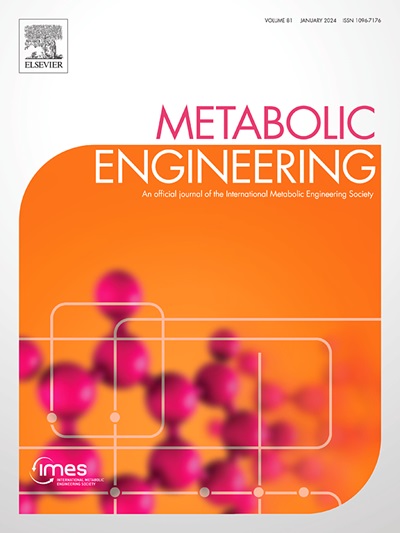Efficient utilization of xylose requires CO2 fixation in Synechococcus elongatus PCC 7942
IF 6.8
1区 生物学
Q1 BIOTECHNOLOGY & APPLIED MICROBIOLOGY
引用次数: 0
Abstract
Cyanobacteria show great promise as autotrophic hosts for the renewable biosynthesis of useful chemicals from CO2 and light. While they can efficiently fix CO2, cyanobacteria are generally outperformed by heterotrophic production hosts in terms of productivity and titer. Photomixotrophy, or co-utilization of sugars and CO2 as carbon feedstocks, has been implemented in cyanobacteria to greatly improve productivity and titers of several chemical products. We introduced xylose photomixotrophy to a 2,3-butanediol producing strain of Synechococcus elongatus PCC 7942 and characterized the effect of gene knockouts, changing pathway expression levels, and changing growth conditions on chemical production. Interestingly, 2,3-butanediol production was almost completely inhibited in the absence of added CO2. Untargeted metabolomics implied that RuBisCO was a significant bottleneck, especially at ambient CO2 levels, restricting the supply of lower glycolysis metabolites needed for 2,3-butanediol production. The dependence of the strain on elevated CO2 levels suggests some practical limitations on how xylose photomixotrophy can be efficiently carried out in S. elongatus.
有效利用木糖需要在伸长 Synechococcus PCC 7942 中进行二氧化碳固定。
蓝藻作为自养宿主,利用二氧化碳和光进行有用化学物质的可再生生物合成,前景十分广阔。虽然蓝藻可以有效地固定二氧化碳,但就生产率和滴度而言,蓝藻通常比异养生产宿主更胜一筹。在蓝藻中实施光混合营养(或共同利用糖和二氧化碳作为碳原料)可大大提高几种化学产品的生产率和滴度。我们在生产 2,3-丁二醇的细长 Synechococcus PCC 7942 菌株中引入了木糖光复作用,并研究了基因敲除、改变途径表达水平和改变生长条件对化学产品生产的影响。有趣的是,在不添加二氧化碳的情况下,2,3-丁二醇的生产几乎完全受到抑制。非靶向代谢组学表明,RuBisCO 是一个重要的瓶颈,尤其是在环境 CO2 水平下,它限制了 2,3-丁二醇生产所需的低级糖酵解代谢物的供应。该菌株对升高的 CO2 水平的依赖性表明,在细长根瘤菌中如何有效地进行木糖光异养生存在一些实际限制。
本文章由计算机程序翻译,如有差异,请以英文原文为准。
求助全文
约1分钟内获得全文
求助全文
来源期刊

Metabolic engineering
工程技术-生物工程与应用微生物
CiteScore
15.60
自引率
6.00%
发文量
140
审稿时长
44 days
期刊介绍:
Metabolic Engineering (MBE) is a journal that focuses on publishing original research papers on the directed modulation of metabolic pathways for metabolite overproduction or the enhancement of cellular properties. It welcomes papers that describe the engineering of native pathways and the synthesis of heterologous pathways to convert microorganisms into microbial cell factories. The journal covers experimental, computational, and modeling approaches for understanding metabolic pathways and manipulating them through genetic, media, or environmental means. Effective exploration of metabolic pathways necessitates the use of molecular biology and biochemistry methods, as well as engineering techniques for modeling and data analysis. MBE serves as a platform for interdisciplinary research in fields such as biochemistry, molecular biology, applied microbiology, cellular physiology, cellular nutrition in health and disease, and biochemical engineering. The journal publishes various types of papers, including original research papers and review papers. It is indexed and abstracted in databases such as Scopus, Embase, EMBiology, Current Contents - Life Sciences and Clinical Medicine, Science Citation Index, PubMed/Medline, CAS and Biotechnology Citation Index.
 求助内容:
求助内容: 应助结果提醒方式:
应助结果提醒方式:


